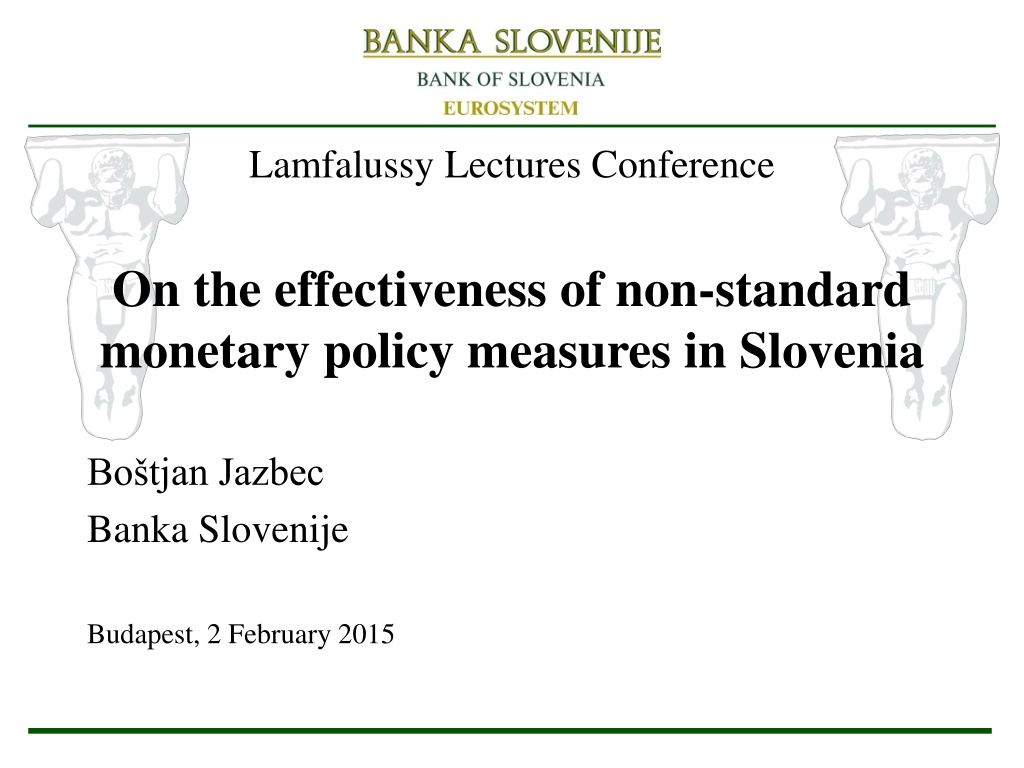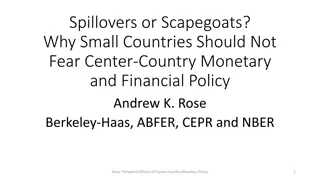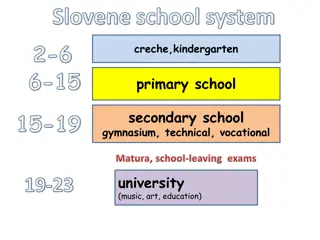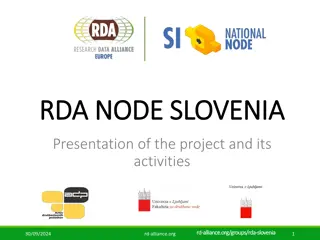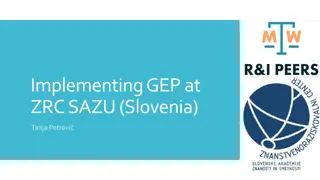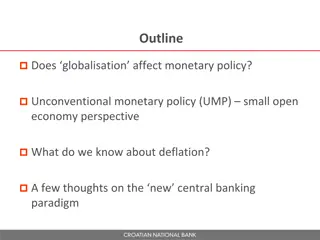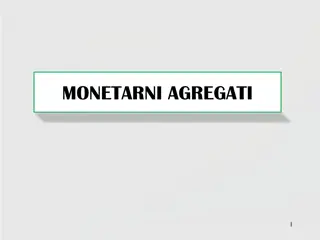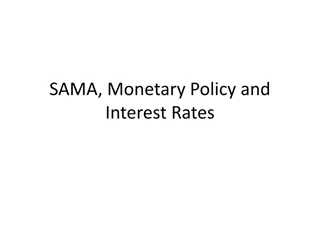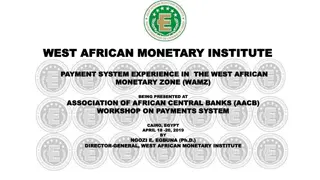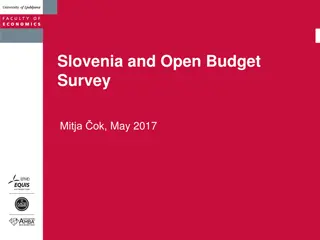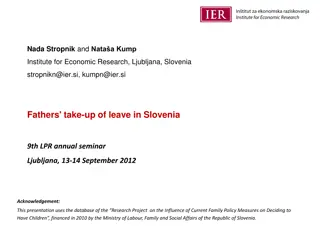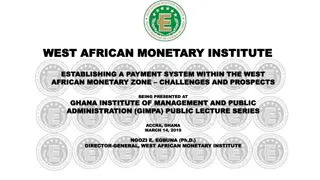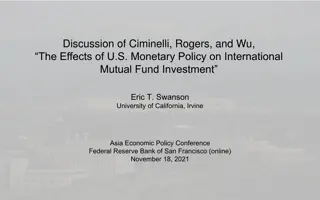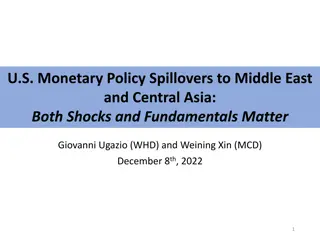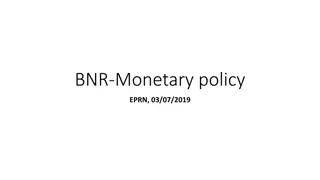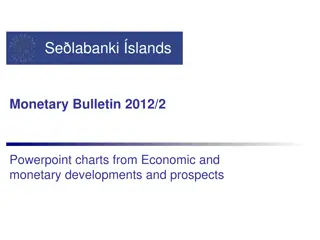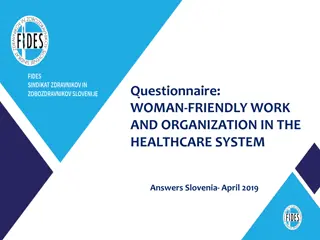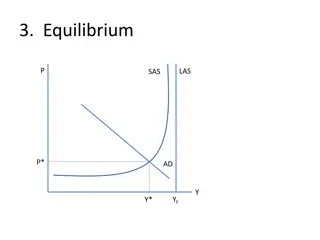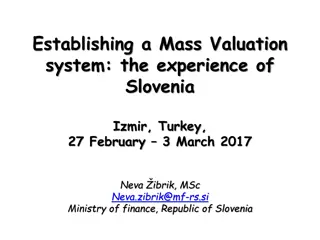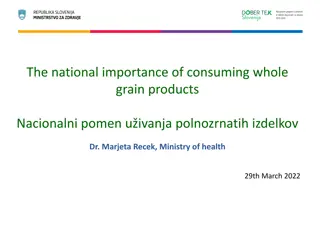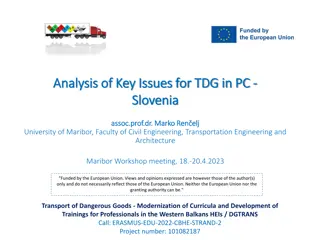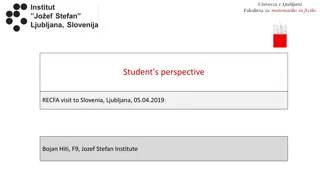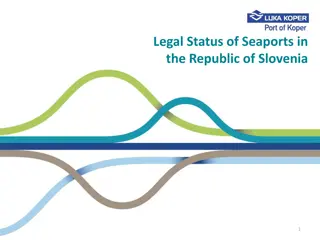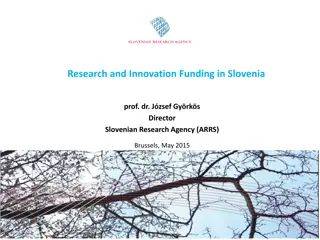Challenges and Solutions in Implementing Non-Standard Monetary Policies in Slovenia
The decoupling of real and financial cycles in Slovenia, attributed to a balance-sheet recession and unsustainable debt-financed growth, poses challenges for monetary policy effectiveness. Credit decline persists despite economic growth, hindered by risk-averse banks and limited market for alternative instruments. Non-standard monetary policy spill-overs can dominate direct effects, requiring holistic policy assistance for repairing transmission channels. Monetary policy provides liquidity but struggles to address impaired channels alone.
Download Presentation

Please find below an Image/Link to download the presentation.
The content on the website is provided AS IS for your information and personal use only. It may not be sold, licensed, or shared on other websites without obtaining consent from the author. Download presentation by click this link. If you encounter any issues during the download, it is possible that the publisher has removed the file from their server.
E N D
Presentation Transcript
Lamfalussy Lectures Conference On the effectiveness of non-standard monetary policy measures in Slovenia Bo tjan Jazbec Banka Slovenije Budapest, 2 February 2015
Summary The decoupling of real and financial cycles is symptomatic of a balance-sheet recession, which impairs the effectiveness of monetary policy. Credit continues to decline, while the economy is back on a growth path. The economic recovery is "domestic credit-less", but not "funding-less". Main impediments to more effective non-standard monetary policy measures rest with risk-averse domestic banking system as well as with the undeveloped market for alternative instruments that would support these measures. In small open economies, and especially in a country with boom-bust legacy, spill-overs of non-standard monetary policy measures complement and could even dominate their direct effects. Monetary policy could be effective in providing liquidity, but is not able to repair the impaired transmission channels without assistance of other policies. 2
The decoupling of real and financial cycles in Slovenia is related to balance-sheet recession and to unsustainable model of debt-financed economic growth during the pre-crisis period. 25 20 15 Percent deviation from trend 10 5 0 2004 Q2 2004 Q3 2004 Q4 2006 Q2 2006 Q3 2006 Q4 2008 Q2 2008 Q3 2008 Q4 2010 Q2 2010 Q3 2010 Q4 2012 Q2 2012 Q3 2012 Q4 2014 Q2 2014 Q3 2004 Q1 2005 Q1 2005 Q2 2005 Q3 2005 Q4 2006 Q1 2007 Q1 2007 Q2 2007 Q3 2007 Q4 2008 Q1 2009 Q1 2009 Q2 2009 Q3 2009 Q4 2010 Q1 2011 Q1 2011 Q2 2011 Q3 2011 Q4 2012 Q1 2013 Q1 2013 Q2 2013 Q3 2013 Q4 2014 Q1 -5 -10 Cyclical comp. of foreign funding of resident banks Cyclical comp. of real GDP -15 Cyclical comp. of firm credit -20 3
The contraction of loans to private sector in Slovenia persists. Hence, the economic recovery is a "domestic credit-less", but not a "funding-less" one. y-o-y growth; % 45 OMT 40 TLTRO 35 BAMC VLTRO 30 25 20 15 10 Crisis begins 5 0 -5 -10 Loans to non-banking sector Loans to corporates (non-financial corporations and OFIs) Loans to non-banking sector, excluding transfer to BAMC Loans to corporates (non-financial corporations and OFIs), excluding transfer to BAMC -15 -20 -25 -30 -35 2007 2008 2009 2010 2011 2012 2013 2014 Source: Bank of Slovenia. 4
Monetary policy was effective in filling the liquidity / funding gap of banking sector after shut down of wholesale markets via FRFA, and later on VLTROs and TLTROs. OMT Crisis begins 1400% 1400% VLTRO TLTRO BAMC 1200% 1200% SI excess liquidity Euro area excess liquidity 1000% 1000% 800% 800% 600% 600% 400% 400% 200% 200% 0% 0% 2007 2008 2009 2010 2011 2012 2013 2014 2015 EUR million VLTRO as share of MFI total assets Share of initial allowance Total TLTRO 1st VLTRO 2nd VLTRO Total VLTRO 1st TLTRO 2nd TLTRO Slovenia 1.466,00 2.233,00 3.699,00 7,1% 75,50 630,88 706,38 71,0% Eurosystem 489.190,75 529.530,81 1.018.721,56 3,0% 82.601,57 129.840,13 212.441,70 53,0% Source: ECB, Bank of Slovenia. Bank of Slovenia calculations. 5
Excess liquidity had no effect on bank lending rates in Slovenia not even for prime borrowers. interestrates on new loans 7 BAMC TLTRO Crisis begins OMT VLTRO 6 Percent (MRO), Percentage points 5 4 3 2 1 0 ECB MRO rate Spread over MRO -"prime" borrowers (A) Spread over MRO -"subprime" borrowers (C) Source: ECB, Bank of Slovenia. Bank of Slovenia calculations 6
Why has there been no impact on lending interest rates in Slovenia? 9000 20% High level of NPLs Transfers to BAMC Non-performing claims, EUR million (left) 8000 15% 7000 Non-performing ratio in % 10% 6000 High leverage of a part of the corporate sector 5% 5000 4000 0% 3000 -5% 2000 -10% 1000 0 -15% 2008 2009 2010 2011 2012 2013 2014 Source: Bank of Slovenia. 7
In Slovenia, banks have been deleveraging since the beginning of the crisis, notwithstanding the non-standard monetary policy measures. 300 Loan to deposit ratio Banking system Large domestic banks 250 Small domestic banks Banks under majority foreign ownership 200 161,5 145,3 142,9 150 134,8 129,8 107,9 100 88,4 50 2008 2009 2010 2011 2012 2013 2014 Source: Bank of Slovenia. 8
Banks in Slovenia have been left with a high level of NPLs. They have not transferred the excess liquidity to the real sector of the economy and at the same time they deleveraged. Such a situation required decisive policy action which included a balance sheet-repair. This was done in the second half of 2013 by a comprehensive review of the banking sector, recapitalisation of major banks and the transfer of NPLs to BAMC. So why are banks not lending even then? Strengthened risk management practices in banks Stronger supervisory oversight The realities of the private sector Some parts of the corporate sector are still suffering from debt overhang Corporate sector is still deleveraging Better clients are able to tap alternative sources of financing, mainly abroad - both by borrowing loans and by issuing bonds 9
Slovenian banks keep their credit standards tightened. BLS: Demand and supply of loans: NFC cumulated net percentage change over the last three months 9 9 Crisis begins 6 6 OMT TLTRO 3 3 VLTRO 0 0 BAMC -3 -3 Level of credit standards - SI Level of demand for financing - SI Level of demand - EA Level of credit standards - EA -6 -6 -9 -9 2007 2008 2009 2010 2011 2012 2013 2014 Source: Bank of Slovenia 10
In Slovenia, there is an increased recourse of private (viable, mostly export oriented corporate) sector to funding from abroad. Share of loans to NFC from abroad 40 The share of foreign held securities in total liabilites of corporate sector reached 1.6% in 2014, compared to 0.6% in 2008. Share of short-term loans from abroad in all short-term loans 35 Share of long-term loans from abroad in all long-term loans 30 25 Percent 20 15 10 5 0 2004 Q1 2004 Q2 2005 Q1 2005 Q4 2006 Q1 2006 Q4 2007 Q4 2008 Q3 2008 Q4 2009 Q3 2010 Q3 2011 Q2 2011 Q3 2012 Q2 2013 Q1 2013 Q2 2014 Q1 2004 Q3 2004 Q4 2005 Q2 2005 Q3 2006 Q2 2006 Q3 2007 Q1 2007 Q2 2007 Q3 2008 Q1 2008 Q2 2009 Q1 2009 Q2 2009 Q4 2010 Q1 2010 Q2 2010 Q4 2011 Q1 2011 Q4 2012 Q1 2012 Q3 2012 Q4 2013 Q3 2013 Q4 2014 Q2 2014 Q3 11
Why additional non-standard monetary policy measures may not be effective in Slovenia? ABS and covered bond programmes face obstacles in Slovenia ABS/covered bonds do not exist owing to small amounts of underlying assets, first mover disadvantage, to smaller extent also due to remaining legal uncertainty and tax issues. Diversification of risks by means of securitisation is weaker, because the pool of underlying assets that can be securitised is small. Banks which are losing their best clients magnify these problems as they may not have sufficient volume of eligible loans. QE the effect of bond purchases may be limited in Slovenia It does not ensure that banks will pass the - yet additional provision of - liquidity into the private sector. Although yield curves are flatter, these effects are not expected to be transmitted to loan pricing conditions. It does not guarantee that banks will be willing to sell bonds at all given that they are risk- averse and faced with very low-yield (or negative-yield) alternative assets. It is expected that the main effect will be an indirect one via spill-overs from other countries, where the above issues are less relevant 12
Summary The decoupling of real and financial cycles is symptomatic of a balance-sheet recession, which impairs the effectiveness of monetary policy. Credit continues to decline, while the economy is back on a growth path. The economic recovery is "domestic credit-less", but not "funding-less". Main impediments to more effective non-standard monetary policy measures rest with risk-averse domestic banking system as well as with the undeveloped market for alternative instruments that would support these measures. In small open economies, and especially in a country with boom-bust legacy, spill-overs of non-standard monetary policy measures complement and could even dominate their direct effects. Monetary policy could be effective in providing liquidity, but is not able to repair the impaired transmission channels without assistance of other policies. 13
Lamfalussy Lectures Conference On the effectiveness of non-standard monetary policy measures in Slovenia Bo tjan Jazbec Banka Slovenije Budapest, 2 February 2015
